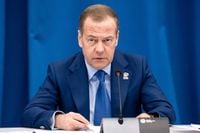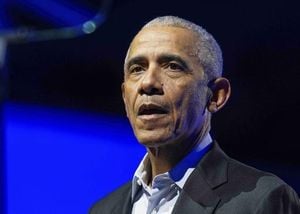On October 13, 2025, a new wave of tension rippled across the already fraught landscape of the Ukraine conflict, as former Russian president Dmitry Medvedev issued a stark warning: the delivery of U.S. Tomahawk cruise missiles to Ukraine could "end badly for everyone," and most notably, for U.S. President Donald Trump. Medvedev’s comments, delivered via Telegram and widely reported by outlets including CBC and Newsweek, underscored the high-stakes brinkmanship now defining relations between Washington and Moscow.
The controversy erupted after Trump, speaking to reporters on Air Force One while en route to Israel, reiterated his openness to providing Ukraine with the long-range Tomahawk missiles if Russian President Vladimir Putin does not end the war. "Yeah, I might tell [Putin], if the war is not settled, we may very well do it," Trump said, as quoted by CBC. "We may not, but we may do it... Do they want to have Tomahawks going in their direction? I don’t think so." The ambiguity of Trump’s statement—"We’ll see"—did little to calm nerves in Moscow or among Western allies.
The Tomahawk missiles at the center of this debate are formidable weapons, with a range of approximately 2,500 kilometers (about 1,550 miles). As The Independent and Newsweek point out, this puts virtually all of European Russia, including Moscow, within their reach. The missiles’ capabilities are similar to the Kalibr cruise missiles Russia itself has used against Ukraine, amplifying the sense of a dangerous tit-for-tat escalation.
Medvedev, who is currently deputy chair of Russia’s security council and a close Putin ally, took to social media to stress the gravity of the situation. He argued that it is "impossible to distinguish between Tomahawk missiles carrying nuclear warheads and conventional ones after they are launched"—a point also made by Kremlin spokesperson Dmitry Peskov. Medvedev’s rhetorical question, "How should Russia respond? Exactly!" was widely interpreted as a veiled nuclear threat. He went further, writing, "One can only hope that this is another empty threat... Like sending nuclear submarines closer to Russia." This was a direct reference to Trump’s August 2025 claim that he had ordered two nuclear submarines to move closer to Russia, in response to what he called "highly provocative" comments from Medvedev about the risk of war.
Medvedev’s warnings were echoed by other Russian officials. On October 8, Andrei Kartapolov, head of the Russian parliamentary defense committee, said Moscow’s response to any Tomahawk deliveries would be "tough, complex, calibrated and asymmetrical." Russian Deputy Foreign Minister Sergey Ryabkov, speaking earlier this month, urged the U.S. to "fully assess the consequences of such a step a thousand times." The Kremlin’s official line, as reiterated by spokesperson Dmitry Peskov, is that the use of such weapons by Ukraine would require direct U.S. participation—a position that raises the specter of direct conflict between the world’s two largest nuclear powers.
For Ukraine, the prospect of receiving Tomahawk missiles represents a potential game-changer in its defense against Russian aggression. President Volodymyr Zelensky said on October 12 and 13 that he had spoken with Trump twice in two days, and that the conversations about "strengthening" Ukraine’s long-range capabilities were "productive." Zelensky has repeatedly stressed that Ukraine would use Tomahawk missiles solely for military purposes and would not target civilians in Russia, should the U.S. provide them. "Ukraine would only use Tomahawk missiles for military purposes and not attack civilians in Russia if provided by the U.S.," Zelensky stated, according to CBC and The Independent.
Kyiv’s foreign ministry has confirmed that discussions about the potential transfer of Tomahawk missiles are ongoing. Heorhii Tykhyi, a spokesperson for Ukraine’s foreign ministry, told domestic media last week, "Right now, there is no 'no' response." The sense in Kyiv is one of cautious optimism, with officials hoping that the U.S. will ultimately consent to Ukraine’s long-standing request for Tomahawk sea-launched missiles—a request that Vice President JD Vance suggested in September 2025 the U.S. might consider.
Yet the debate is not limited to military calculations. The political stakes are enormous, especially for President Trump. Medvedev, never one to mince words, singled out Trump in his warning, writing that the delivery of Tomahawks could end badly "most of all, for Trump himself." The two men have a history of public clashes, with Trump once labeling Medvedev a "stupid person," and Medvedev alluding to Russia’s "dead hand" nuclear mechanism—designed to launch nuclear weapons even if Russia’s senior commanders are incapacitated. These personal animosities now play out against the backdrop of a potentially world-altering policy decision.
Putin himself has weighed in, warning that supplying Ukraine with Tomahawks would "destroy relations between the United States and Russia." The Russian leader’s words are not mere bluster; they reflect a deeply held view in Moscow that the introduction of such weapons would cross a red line, with unpredictable consequences for global security. According to Newsweek, Russian officials have repeatedly asserted that Ukraine cannot use Tomahawks without U.S. involvement—a claim that, if true, could make the U.S. a direct participant in the war.
The possibility of Tomahawk transfers has also sparked debate within the U.S. and among its allies. Some Western officials and analysts argue that providing Ukraine with longer-range strike capabilities is essential to leveling the playing field and deterring further Russian aggression. Others worry that such a move could provoke a dangerous escalation, especially given Russia’s repeated warnings and its doctrine of nuclear ambiguity regarding weapons that could carry both conventional and nuclear warheads.
Meanwhile, Ukrainian officials insist that their country’s fight is existential and that only robust Western support—including advanced weaponry—can ensure its survival. The ongoing discussions between Kyiv and Washington reflect both the urgency of Ukraine’s needs and the complexity of the geopolitical calculus facing the U.S. administration. As one Kyiv official put it, "There is a very detailed and active discussion about the possibility of providing these missiles."
As the world watches anxiously, the fate of the Tomahawk missiles—and the broader trajectory of the Ukraine conflict—hangs in the balance. The choices made in Washington and Moscow in the coming weeks could reverberate far beyond the battlefields of eastern Europe, shaping the contours of global security for years to come.
For now, the warnings from Moscow, the deliberations in Kyiv and Washington, and the public sparring between Trump and Medvedev serve as reminders that, in this conflict, words can be as potent—and as perilous—as missiles themselves.




